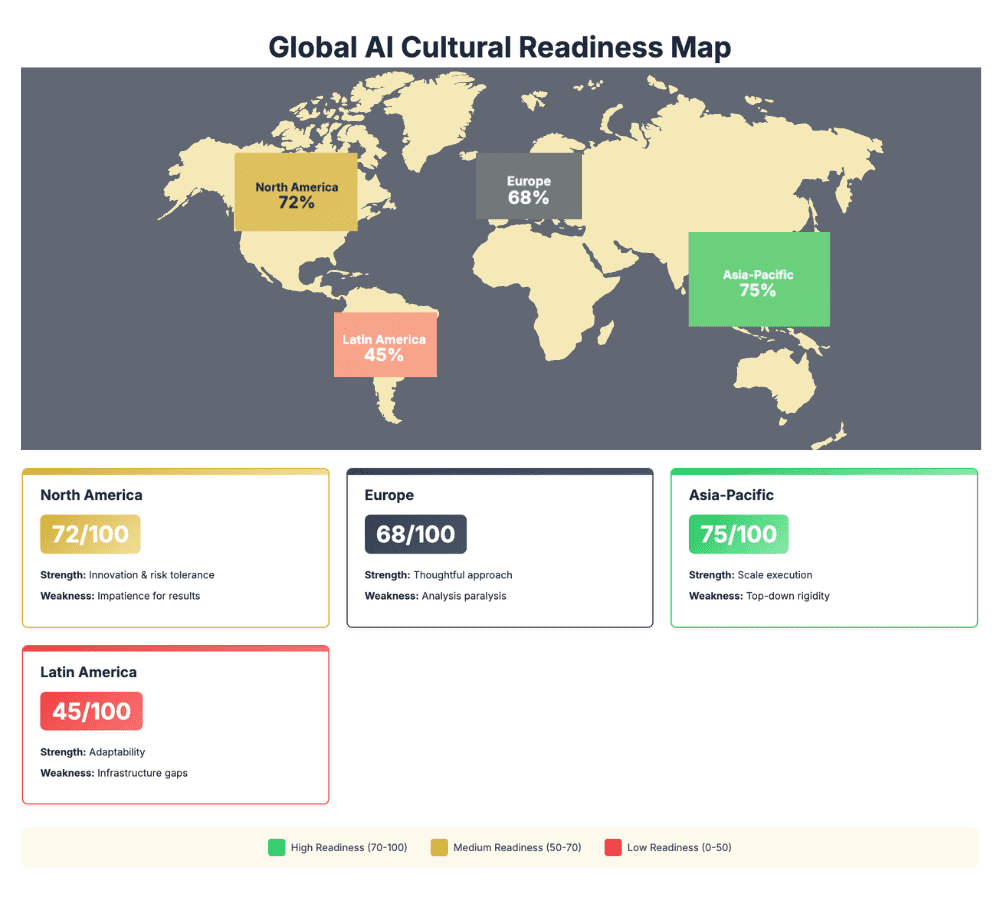Meta Description: Discover why 67% of AI projects fail due to cultural barriers, not technology. Learn JPMorgan’s proven framework for transforming 200,000 employees into AI collaborators with 30% higher ROI.
Executive Summary
Key Takeaways:
- 67-80% of AI projects fail primarily due to cultural resistance, not technical limitations
- Organizations investing in cultural transformation achieve 1.6x higher success rates and 30% better ROI
- JPMorgan Chase’s 200,000+ employees using AI across 450+ use cases proves culture beats technology
- Human-AI collaboration outperforms either alone when properly designed
- The next 5 years will see AI agents as full team members, requiring immediate cultural preparation
Business Impact: Organizations with mature AI cultures report 20-40% productivity improvements within 12 months, while culturally unprepared companies face 2-4 year delays.
ROI Preview: Every dollar invested in cultural change management returns $3.20 in AI project value realization, with breakeven at 8 months.

Introduction: The $5 Billion Warning Sign
When IBM Watson Health collapsed—a $5 billion investment sold for approximately $1 billion—the technology wasn’t the problem. The algorithms worked. The data was there.
What failed? The humans.
You’re investing millions in AI initiatives right now. Your competitors are too. But here’s where it gets interesting: 80% of you will fail, according to RAND Corporation’s latest research. Not because your technology isn’t sophisticated enough, but because your people aren’t ready for the transformation.
When you examine JPMorgan Chase’s journey from 2020 to today, you see something remarkable. They didn’t just deploy AI tools—they transformed 200,000+ employees into AI collaborators across 450+ use cases. Today, they lead the Evident AI Index for the third consecutive year. Their secret? They started with culture, not code.
The data reveals something unexpected: Organizations that invest in cultural transformation are 1.6x more likely to exceed AI expectations and achieve 30% higher ROI than those focusing purely on technical implementation.

What is Human-AI Partnership?
The Human-AI Partnership is a collaborative model where humans and AI systems work together, each leveraging their unique strengths. Humans provide contextual understanding, emotional intelligence, and ethical reasoning, while AI handles high-volume data processing, pattern recognition, and consistent 24/7 performance. This partnership achieves 1.6x higher success rates than either humans or AI working alone.
The Shocking Reality: Understanding the 67% Failure Crisis
Recent comprehensive studies paint a sobering picture:
- 80% of AI projects fail (RAND Corporation, 2024)
- Only 48% make it to production (Gartner, 2024)
- 42% of companies abandoning AI initiatives in 2025 (S&P Global)
- Less than 20% of organizations track KPIs for GenAI solutions (McKinsey)

But here’s what catches teams off guard: The same AI technology succeeds in finance and fails in healthcare. The difference? Cultural readiness.
You’re probably thinking about technical challenges—data quality, model accuracy, infrastructure. Yes, 43% cite data issues, but dig deeper. The real culprits:
- 83% of employees feel unprepared for AI collaboration
- 47% receive zero training on AI tools they’re expected to use
- Fewer than 1% of executives describe their GenAI rollouts as “mature”
When you map success rates across industries, patterns emerge. Financial services achieves 70%+ success through data-centric culture and strong change management. Healthcare struggles at 25% due to physician resistance and workflow disruption.

Cultural Barriers: The Five Walls You Must Demolish
Wall #1: The Fear Factor
Your employees aren’t paranoid. The World Economic Forum predicts automation will displace 85 million jobs by 2025. Before you worry about implementation, understand what you’re fighting:
- Opacity: “I don’t understand how it makes decisions”
- Emotionlessness: “It doesn’t care about our customers”
- Autonomy loss: “I’m becoming its assistant”
Wall #2: The Knowledge Vacuum
- Only 17% feel “very prepared” to work with AI
- 62% don’t understand basic AI concepts

Wall #3: The Silo Fortress
Traditional structures sabotage AI success. IT protects their domain. Business units resist standardization. Legal blocks experimentation.
Wall #4: The Identity Crisis
When Memorial Sloan Kettering’s physicians rejected IBM Watson, it wasn’t about performance. Watson challenged their professional identity—their very reason for existing.
Wall #5: The Workflow Worship
Your teams spent years perfecting processes. Now you’re asking them to abandon what works for something uncertain.

The Human-Agent Partnership Model: Your New Operating System
Reframing the Relationship
MIT research reveals the breakthrough: Human-AI teams excel when “each party can do what they do better than the other.”
What Humans Do Better:
- Contextual understanding
- Emotional intelligence
- Creative problem-solving
- Ethical reasoning
What AI Does Better:
- High-volume data processing
- Pattern recognition at scale
- Consistent 24/7 performance
- Objective analysis

The Missing Middle: Where Magic Happens
Accenture discovered the real value isn’t in human OR machine performance, but in the collaborative space between them:
Healthcare: Google’s AI matches radiologists in cancer detection. Combined with physician care: 30% faster diagnosis, 15% better accuracy.
Finance: JPMorgan saves 360,000 hours annually on document review through human-AI collaboration.
Retail: Walmart’s 2.3 million associates use AI for inventory while maintaining personal touch. Result: 10x customer satisfaction increase.

Organizational Transformation Strategies That Actually Work
The 6-Step Framework
Here’s what catches teams off guard: You can’t copy Silicon Valley’s playbook. You need an approach tailored to your culture.
Step 1: Pick Your Battles (Months 1-2) Choose technically feasible pilots with 6-12 month wins. Combine internal expertise with external AI knowledge.
Step 2: Build Your Coalition (Months 2-3) Identify influential early adopters. Create cross-functional tiger teams. Empower champions with resources.
Step 3: Create Your AI Dojo (Months 3-6) Establish hands-on learning labs. Develop role-specific curricula. Make learning social, not solitary.
Step 4: Launch Visible Wins (Months 4-8) Deploy pilots with measurable impact. Communicate successes broadly. Scale what works.
Step 5: Embed New Behaviors (Months 6-10) Adjust performance metrics. Reward collaboration. Normalize experimentation.
Step 6: Scale and Sustain (Months 10-12) Expand successful patterns. Create continuous learning loops. Build innovation momentum.

Leadership Strategies That Convert Skeptics
The CEO Imperative: Jamie Dimon didn’t just announce AI adoption—he demonstrated personal learning and measured managers on AI integration. Result: 3x faster adoption than industry average.
The Middle Management Multiplier: Reframe their role from task managers to strategic orchestrators, from report generators to insight interpreters.
Role-Specific Training That Transforms

Case Studies: Million-Dollar Lessons
JPMorgan Chase: The $1.5 Billion Success Story
Starting Point (2020): 250,000 employees, fragmented AI experiments, skeptical workforce
Transformation:
- CEO commitment: “Every employee uses AI daily”
- Created AI Research division with 200+ PhDs
- Built secure AI sandbox environments
- Established test-and-control methodology
Results (2025):
- 450+ AI use cases in production
- #1 on Evident AI Index (3 consecutive years)
- $1.5 billion annual value creation

IBM Watson Health: The $4 Billion Lesson
What Went Wrong:
- Imposed AI on physicians without input
- Ignored workflow integration
- Underestimated identity threat
- Technical focus over cultural readiness
The Collapse:
- $5 billion investment sold for ~$1 billion
- Partnerships terminated
- Physician rebellion
Key Lesson: Technical superiority doesn’t guarantee adoption when you ignore human factors.

ROI Methodology: The Numbers That Justify Everything
The Investment Framework
Direct Costs:
- Training: $2,000-5,000 per employee
- Change management: 15-20% of AI project budget
- Cultural consultancy: $100K-500K
Hidden Costs Often Missed:
- Productivity dip: 10-15% for 3 months
- Opportunity cost of delay: $1M-10M per quarter
Run the interactive ROI calculator
The Return Multiplier

Global Perspectives: Navigating Cultural Complexity

Your 90-Day Transformation Sprint
Immediate Next Steps (Week 1)
- Conduct Cultural Readiness Assessment
- Survey workforce AI attitudes
- Identify resistance pockets
- Baseline current capabilities
- Establish AI Transformation Office
- Appoint transformation leader
- Create cross-functional team
- Define success metrics
- Launch Communication Campaign
- Address job security fears directly
- Share augmentation vision
- Create feedback channels
30-Day Momentum Builders
- Select High-Visibility Pilots
- 3-6 month completion targets
- Clear success criteria
- Mixed technical/business teams
- Begin Leadership Transformation
- Executive AI immersion sessions
- Middle management workshops
- Public learning commitment
90-Day Success Metrics

Resource Requirements

Conclusion: Your Choice Point
The evidence is overwhelming. You face a simple choice: Join the 20% who succeed by investing in cultural transformation first, or join the 80% who become cautionary tales.
The 67% failure rate isn’t a technology problem—it’s a human challenge demanding human solutions. Organizations investing in cultural transformation are 1.6x more likely to exceed expectations and achieve 30% higher ROI.
You’ve seen what works: JPMorgan Chase transforming 200,000 employees. You’ve seen what fails: IBM Watson’s $4 billion collapse. The pattern is clear. Start with culture, not code.
Every month you delay adds three months to your journey. By 2030, organizations will divide into AI-native and AI-resistant, with little middle ground.
Your next 90 days determine your next 5 years. The playbook is proven. The ROI is documented. Will you transform your culture to unlock AI’s potential, or join the graveyard of technically sophisticated, culturally naive failures?
Your transformation starts now.

